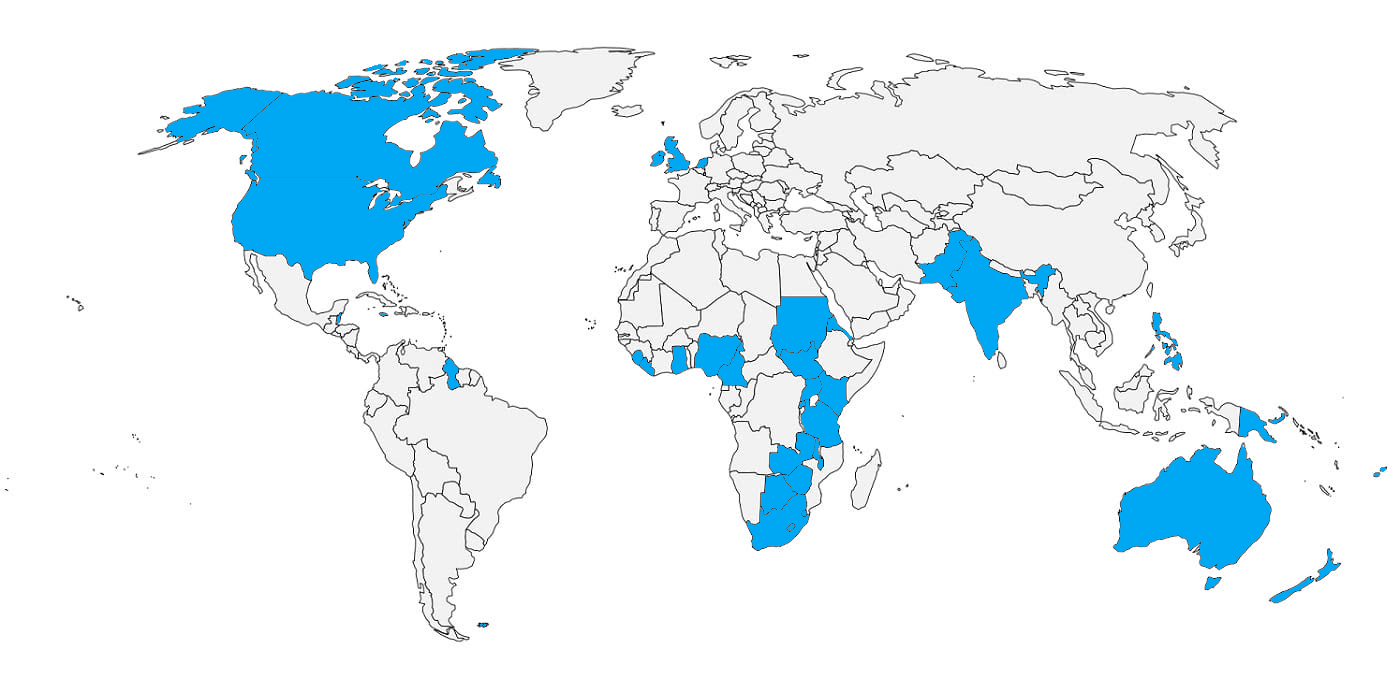Map of Countries with English as an Official Language


Marcus Rodriguez
Historical Geography Expert
Marcus Rodriguez specializes in historical cartography and geographic data analysis. With a background in both history and geography, he brings unique...
Geographic Analysis
What This Map Shows
This visualization outlines the countries where English is recognized as an official language, whether solely or alongside other languages. From the United States to Jamaica, this map provides a clear snapshot of the global footprint of English as a language of governance, education, and communication. It highlights not just the geographic spread of English but also hints at historical connections, colonial legacies, and modern geopolitical relationships.
Deep Dive into English as an Official Language
English has evolved from its roots in medieval England to become one of the most widely spoken languages globally. Interestingly, it's estimated that approximately 1.5 billion people speak English worldwide, with around 375 million native speakers. Countries that designate English as an official language often have diverse linguistic landscapes due to historical colonization, trade relationships, and migration patterns.
Have you noticed that many Caribbean nations, like Barbados and Trinidad and Tobago, use English as their primary official language? This stems from British colonization, which left a lasting legacy on the region's languages and cultures. Similarly, in countries like India and Nigeria, English serves as a lingua franca among various ethnic groups, facilitating communication in a linguistically diverse environment.
The role of English varies significantly across these nations. In many African countries, such as Kenya and Uganda, English is used in government, education, and media, while indigenous languages also thrive. According to the 2023 Ethnologue report, there are over 500 languages spoken in Nigeria, making the use of a common language like English essential for national unity.
Moreover, English proficiency has become increasingly important in the global job market. Countries that have embraced English often see an influx of foreign investment, tourism, and business opportunities. This phenomenon is particularly evident in emerging economies where English is taught as a second language in schools, preparing students for a globalized workforce.
Interestingly, the demand for English language education continues to grow, with many non-native speakers striving to master it for personal and professional reasons. In places like Singapore, where English is one of four official languages, the government promotes English as a key medium of instruction and communication, reflecting its significance in the country’s multicultural society.
Regional Analysis
When breaking down the map by regions, we can see distinct patterns and variations in how English is utilized. In North America, English is predominant in the United States and Canada, where it functions as the primary language for government and education. However, Canada also recognizes French as an official language, showcasing a bilingual approach that reflects its diverse population.
Moving to the Caribbean, countries like The Bahamas and Saint Lucia prominently feature English, but they also incorporate Creole languages and dialects, which enrich the cultural fabric of the region. In contrast, smaller nations such as Saint Kitts and Nevis solely rely on English, illustrating a different linguistic dynamic.
In Africa, the situation becomes more complex. English is often a second language in countries like South Africa, where 11 official languages exist, and is used mainly in urban areas and formal settings. Meanwhile, in nations like Zimbabwe and Zambia, English serves as a unifying language amidst a backdrop of numerous local dialects, showcasing its adaptability and importance.
Asia presents a fascinating case with countries like India and the Philippines integrating English deeply into their societal structures. In India, English coexists with Hindi and several regional languages, a remnant of British colonial rule. The Philippines, on the other hand, has adopted English as a primary medium of instruction in schools, leading to a high level of English fluency among its citizens.
Significance and Impact
Understanding the spread of English as an official language is crucial in today's interconnected world. It influences international relations, trade, and cultural exchange. Countries that embrace English often benefit economically, as it opens doors to global markets and enhances diplomatic ties.
Moreover, as the world becomes more globalized, the role of English continues to evolve. Future projections suggest that the number of people learning English will only increase, especially in non-English speaking countries. This trend raises questions about the preservation of indigenous languages and cultures, as English dominance may overshadow local dialects.
In conclusion, the map of countries with English as an official language offers a lens through which we can examine historical, cultural, and economic connections worldwide. It highlights not only the reach of the English language but also the rich tapestry of languages and cultures that coexist with it. As we navigate this globalized landscape, understanding the significance of English can provide valuable insights into communication, education, and international collaboration.
Visualization Details
- Published
- October 27, 2025
- Views
- 4
Comments
Loading comments...